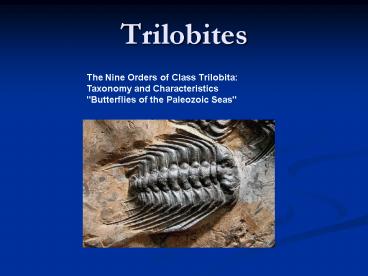Trilobites PowerPoint PPT Presentation
1 / 15
Title: Trilobites
1
Trilobites
The Nine Orders of Class TrilobitaTaxonomy and
Characteristics"Butterflies of the Paleozoic
Seas"
2
(No Transcript)
3
(No Transcript)
4
- The Paleozoic is often called the age of the
trilobite.Trilobites particularly flourished in
the oceans of the Cambrian and Ordovician
periods, beginning around 540 million years ago,
with a diminishing number of families persisting
until the Permian. The number of families
actually peaked in the Late Cambrian when an
extinction event removed many. The morphological
diversity actually peaked in the Ordovician. Many
more families were removed at the end of the
Ordovician 440 million years ago during a great
ice age where ice sheets advanced to the equator.
5
- The diminished number of trilobite families that
survived to the Silurian radiated into new and
exotic forms, and still more exotic spiny and
pustulose forms in the Devonian. The Devonian was
punctuated by periods of rising seas that
disrupted the reef systems where the trilobites
flourished forcing selective adaptation. The end
of the Devonian saw the Frasnian-Famennian event
where only Proteus survived into the
Carboniferous.
6
Mass extinction
- Failing to adapt to deep-water habitats, their
vulnerability to climatic change remained and led
to their disappearance prior to yet another great
mass extinction at the end of the Permian. The
age of the trilobite yielded to the age of the
insect.
7
Agnostida
- Among the most primitive of trilobites
- Length of a few mm and smaller
- Similar cephalon and pygidium (isopygous)
- Lower Cambrian to Upper Ordovician
8
Redlichiida
- Among the most primitive of trilobites
- Many thoracic segments
- Spinocity usually limited to pleurae tips
- Small pygidium
- Lower to Middle Cambrian
9
Corynexochida
- Hypostomal attachment in common
- Normally spinous
- Lower to Middle Cambrian
10
Lichida
- Often elaborate and often highly spinous (making
them highly sought) - Ordovician to Devonian
11
Phacopida
- Particularly noted for detailed preservation of
compound eyes - Typical deep furrows between thoracic segments
- Typically not spinous
- Lower Ordovician to Upper Devonian
12
Proetida
- Among the last survivors before Trilobita faded
away, and disappeared in the Permian extinction - Typically small with small spineless pygidium
- Ordovician to Permian
13
Asaphida
- Ubiquitous trilobite sharing distinct suture
structure - Effacement of features common with typically
large pygidium - Middle Cambrian to Lower Silurian
14
Harpetida
- Presence of the broad semicircular to ovate brim
- Lack of rostral plate
- Upper Cambrian to Upper Devonian
15
Ptychopariida
- Appeared early and persisted long, yielding much
variability in form - Formerly included what is now Order Harpina
- Lower Cambrian to Devonian
http//www.fossilmall.com/Science/About_Trilobites
.htm

